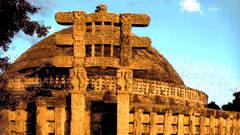In the Mauryan Empire they had many volunteer soldiers. King Darius,
of Persia, conquered part of the Persian Empire, and after he conquered
that empire he
helped pay taxes in the Mauryan Empire, which in return helped, pay
many volunteer citizen soldiers. These volunteered soldiers helped in the
Persian invasion of
Greece.
If a network of Persian spies can be believed, Chandragupta's army
consisted of 600,000 men, 9,000 elephants, chariots, and a naval auxiliary.
All of these components
were paid by the royal treasury, which again means that these
men in the army were volunteer citizen soldiers.
Some smart people from the Mauryan Empire state that Asoka's death
resulted in the rapid fall of the Mauryan Empire. These scholars also
state that after Asoka's
death the military weakened. There might have been many volunteer
citizen soldiers in Asoka's army, which means that Asoka might have been
a good payer to these
volunteer soldiers. There were also Mauryan people who worked
as laborers.
Most Mauryan People worked on farms which were either there own or
owned by the city. If people didn't work on farms then they worked as
animal herders,
weavers, or pottery makers. A large section worked in the army, like
I stated above, they were paid well and lived a comfortable life. All
of these people paid taxes
except for Hindu priests, Buddhist, and Jain monks.
Bibliography:
World History: Upshur, Terry, Holoka, Goff,
and Cassar; Wadsworth/Thomson Learning
www.indianvisit.com/ivnew/thecountry/history/mauryanempire.htm
BY:
DUTCH GAITLEY

